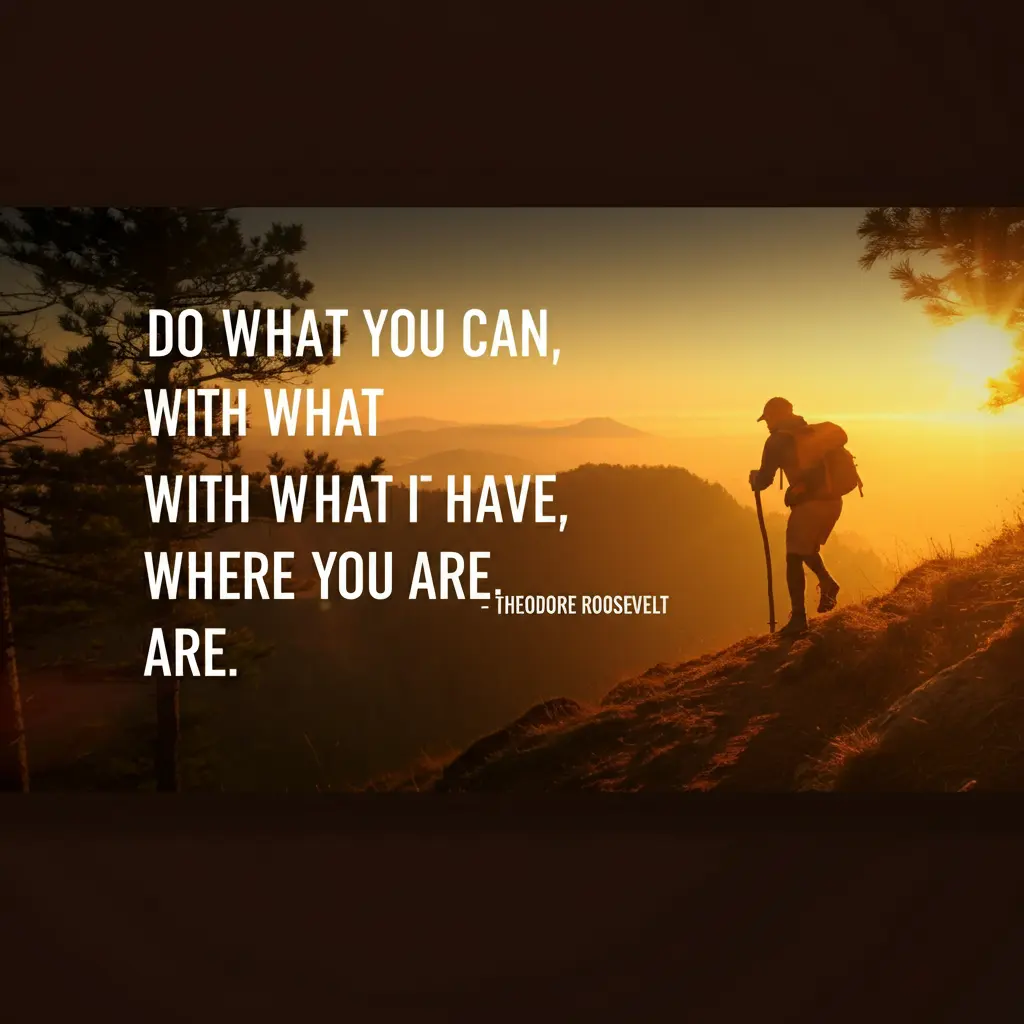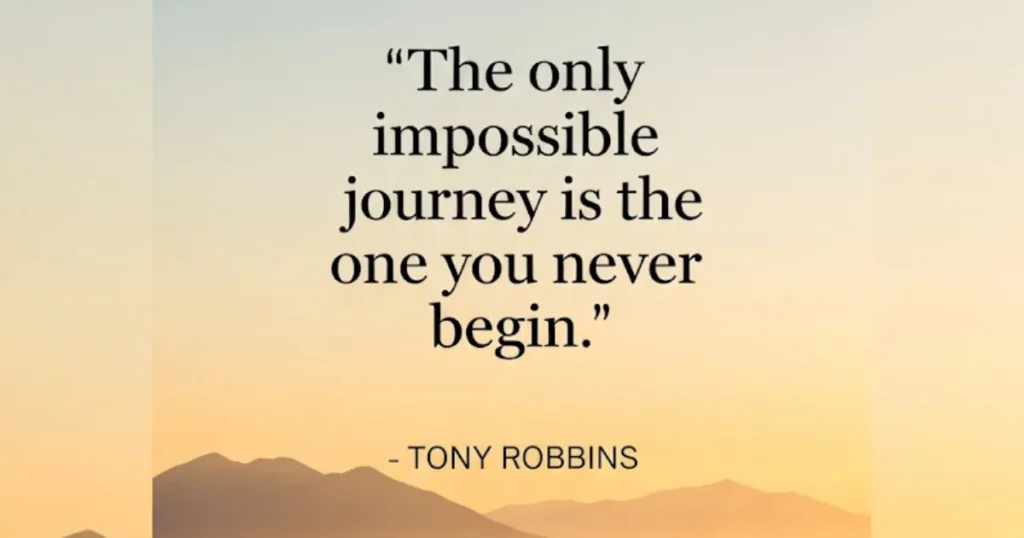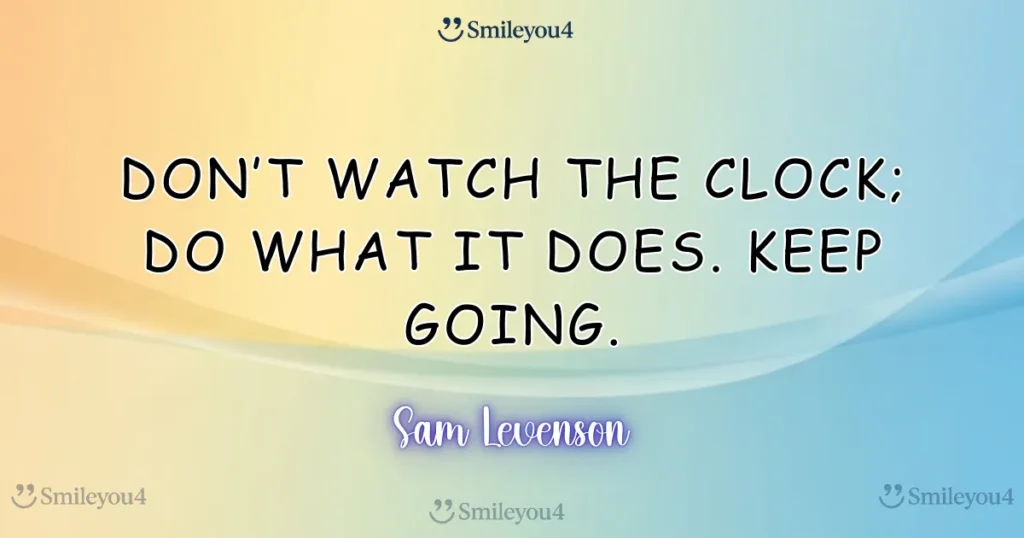You’re staring at a mountain of goals, dreams deferred, and challenges that feel impossible to overcome. Sound familiar? Here’s the truth that changed everything for me: you don’t need perfect conditions to create extraordinary results. Theodore Roosevelt understood this when he said, “Do what you can, with what you have, where you are.” This simple yet profound philosophy has the power to transform your entire approach to life, starting today.
When you embrace the mindset to do what you can with your current resources and circumstances, you unlock a superpower that most people never discover. You stop waiting for someday and start building your dreams right now.

The Revolutionary Power of “Do What You Can”
Why Roosevelt’s Philosophy Changes Everything
Theodore Roosevelt wasn’t speaking from comfort when he shared this wisdom. He faced asthma as a child, personal tragedies, political battles, and countless setbacks. Yet he became one of America’s most accomplished presidents because he mastered the art of working with what he had.
Do what you can isn’t about settling for less—it’s about maximizing your current potential while building toward bigger dreams. This mindset shift eliminates the paralysis of perfectionism and transforms you into someone who takes consistent action.
Think about it: how many dreams have you put on hold waiting for the “right” moment, resources, or circumstances? Roosevelt’s wisdom teaches us that the right moment is now, and the right resources are whatever you currently possess.
The Science Behind Taking Action with What You Have
Research shows that people who do what you can with available resources develop stronger problem-solving skills, higher resilience, and greater life satisfaction. When you work within constraints, your brain activates creative pathways that remain dormant when resources seem unlimited.
Studies from Stanford University reveal that constraints actually boost creativity by 300%. When you commit to do what you can regardless of limitations, you train your mind to find innovative solutions that others miss entirely.
This isn’t just positive thinking—it’s practical neuroscience. Every time you choose to act despite imperfect conditions, you strengthen neural pathways associated with resilience, adaptability, and resourcefulness.
Real-Life Applications: How to Do What You Can Today
Career Growth When Resources Feel Limited
Here’s how to apply this wisdom professionally:
- Skill Development: Use free online courses, YouTube tutorials, and library resources to build expertise
- Network Building: Connect with colleagues, join professional groups, and offer help before asking for it
- Value Creation: Look for problems you can solve with your existing skills and knowledge
- Portfolio Building: Document your work, create case studies, and showcase your impact
Sarah, a customer service representative, wanted to move into marketing but felt stuck without experience. Instead of waiting for permission, she started creating social media content for her department, analyzing engagement metrics, and presenting insights to management. Within six months, she landed a marketing coordinator role. She chose to do what you can instead of waiting for ideal circumstances.
Building Relationships with Current Resources
Strong relationships aren’t built with expensive gifts or grand gestures—they’re built through consistent small actions that show you care. When you do what you can to strengthen connections, you create a support network that transforms every area of your life.
Relationship-building actions you can take today:
- Send a thoughtful text to someone you haven’t contacted recently
- Offer specific help based on your skills and availability
- Listen actively without trying to fix or judge
- Celebrate others’ successes genuinely and publicly
- Share valuable resources or connections that could benefit them
Health and Wellness Without Perfect Conditions
You don’t need a gym membership, expensive equipment, or hours of free time to improve your health. When you do what you can with your current schedule and resources, small actions compound into significant results.
Immediate wellness actions:
- Take the stairs instead of elevators
- Do bodyweight exercises during TV commercials
- Pack healthy snacks to avoid vending machine temptations
- Drink water before every meal
- Take walking meetings when possible
- Practice deep breathing during stressful moments
Overcoming the “Not Enough” Mindset
Why We Resist Doing What We Can
Most people resist the philosophy to do what you can because it challenges comfortable excuses. It’s easier to blame circumstances than to take responsibility for progress within those circumstances.
Common resistance patterns:
- “I don’t have enough time” (Reality: Everyone has the same 24 hours)
- “I don’t have enough money” (Reality: Many solutions require creativity, not cash)
- “I don’t have enough experience” (Reality: Experience comes from doing, not waiting)
- “I don’t have the right connections” (Reality: Valuable connections form through mutual benefit)
When you shift from “not enough” thinking to “do what you can” thinking, you discover resources you never noticed and possibilities that seemed impossible.
The Compound Effect of Small Actions
Every time you do what you can with available resources, you create momentum that attracts better opportunities. This compound effect works like interest—small, consistent actions grow exponentially over time.
How compound action works:
- Initial Action: You do something small with current resources
- Skill Development: You learn from the experience and improve
- Confidence Building: Success builds belief in your abilities
- Opportunity Creation: Your actions attract notice and new possibilities
- Resource Expansion: Better opportunities provide better resources
- Accelerated Growth: Enhanced resources enable bigger actions
## Practical Steps to Do What You Can Right Now
The “Available Resources” Audit
Before you do what you can, you need to know what “can” actually includes. Most people underestimate their available resources because they focus on what they lack instead of what they possess.
Complete this audit:
- Skills: List every skill you have, including soft skills like listening or problem-solving
- Knowledge: Consider your education, experience, and specialized knowledge
- Network: Include everyone you know, from family to acquaintances
- Tools: Inventory your technology, equipment, and access to facilities
- Time: Identify pockets of available time, even 15-minute blocks
- Energy: Note your high-energy periods for tackling challenging tasks
Creating Your “Do What You Can” Action Plan
Transform Roosevelt’s wisdom into a practical system that drives daily progress toward your goals.
Step 1: Define Your Desired Outcome
Be specific about what you want to achieve, but flexible about how you’ll get there.
Step 2: Identify Immediate Actions
List 10 things you could do what you can accomplish this week with current resources.
Step 3: Start with the Smallest Step
Choose the easiest action and complete it today. Momentum matters more than perfection.
Step 4: Build Consistency
Commit to one small daily action that moves you forward, regardless of circumstances.
Step 5: Track and Adjust
Monitor progress and adapt your approach based on results and changing resources.
Daily Habits That Embody “Do What You Can”
Morning Routine:
- Review your goals and identify today’s possible actions
- Choose one priority that you can advance with available resources
- Set an intention to notice opportunities throughout the day
Workday Integration:
- Look for ways to add value using your current skills
- Offer help to colleagues when you can provide meaningful assistance
- Document lessons learned and insights gained
Evening Reflection:
- Celebrate what you accomplished with available resources
- Identify tomorrow’s “do what you can” opportunity
- Plan how to maximize your existing assets
Success Stories: Real People Who Did What They Could
From Limitation to Innovation
James Dyson created his revolutionary vacuum cleaner after 5,126 failed prototypes. He didn’t wait for perfect funding or ideal conditions—he chose to do what you can with his engineering background and relentless determination.
Spanx founder Sara Blakely started her billion-dollar company with $5,000 savings and no business experience. She cut the feet off pantyhose, researched patents at the library, and cold-called manufacturers. She epitomized the decision to do what you can with available resources.
Colonel Sanders was 65 and broke when he started KFC. He drove around the country sleeping in his car, cooking chicken for restaurant owners until someone agreed to use his recipe. He proved that age and circumstances don’t limit what you can accomplish when you do what you can consistently.
Your Success Story Starts Today
Every person who has achieved something meaningful has a moment when they decided to do what you can instead of waiting for perfect conditions. That moment is available to you right now.
What would you attempt if you knew you couldn’t fail? Now, what small step toward that goal could you take today with your current resources? That’s your starting point.
## Expanding Your “What You Can Do”
Growing Your Capacity Over Time
When you consistently do what you can with available resources, something magical happens—your capacity grows. Skills develop, networks expand, confidence builds, and new resources become accessible.
How capacity expands:
- Skill Multiplication: Each new skill combines with existing ones to create unique capabilities
- Network Effects: Every person you help or connect with expands your reach
- Reputation Building: Consistent action creates a reputation that opens doors
- Resource Attraction: Success with limited resources often attracts better resources
- Confidence Compounding: Each achievement makes the next challenge feel more manageable
Building Systems for Continuous Growth
Do what you can isn’t a one-time decision—it’s a lifestyle that requires systems and habits.
Create these supporting systems:
- Learning System: Dedicate time weekly to skill development using free or low-cost resources
- Networking System: Regularly reach out to new people and nurture existing relationships
- Documentation System: Track your progress, lessons learned, and resource discoveries
- Opportunity System: Train yourself to notice and evaluate potential opportunities
- Recovery System: Plan for setbacks and maintain momentum during difficult periods
Related Wisdom for Your Journey
As you embrace the power to do what you can with your current resources, consider these complementary insights:
“A journey of a thousand miles begins with a single step.” – Lao Tzu
Every massive achievement started with someone choosing to act with what they had available.
“You are never too old to set another goal or to dream a new dream.” – C.S. Lewis
Your current circumstances don’t determine your future possibilities when you do what you can consistently.
“The best time to plant a tree was 20 years ago. The second best time is now.” – Chinese Proverb
Perfect timing doesn’t exist, but present action creates future possibilities.
Your Next Step: Do What You Can Today
Roosevelt’s wisdom isn’t meant to be admired—it’s meant to be lived. Right now, you have everything you need to take meaningful action toward your dreams.
Stop waiting for:
- More time
- Better resources
- Perfect conditions
- External permission
- Complete clarity
Start with what you have:
- Your current skills and knowledge
- The people you know
- The time available today
- The tools you can access
- The energy you possess
Here’s your immediate action plan:
- Choose One Goal: Pick something you’ve been postponing due to resource limitations
- Identify Available Resources: List what you currently have that could contribute to this goal
- Take One Small Action: Do something today that moves you forward, however slightly
- Share Your Commitment: Tell someone about your decision to do what you can starting now
Remember, you don’t need to see the whole staircase to take the first step. When you do what you can with courage and consistency, the path reveals itself as you walk it.
Your dreams are waiting for action, not perfect conditions. What will you choose to do with this moment? The power to do what you can is in your hands right now.
Ready to transform your life by doing what you can with what you have? Share this article with someone who needs to hear Roosevelt’s wisdom, and commit to taking one action today that proves you’re ready to stop waiting and start building your extraordinary life.


